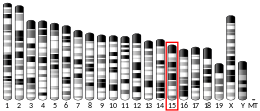MAPK12
Mitogen-activated protein kinase 12 (MAP kinase 12), also known as extracellular signal-regulated kinase 6 (ERK6) or stress-activated protein kinase 3 (SAPK3), is an enzyme that in humans is encoded by the MAPK12 gene.[5]
Function
Activation of members of the mitogen-activated protein kinase family is a major mechanism for transduction of extracellular signals. Stress-activated protein kinases are one subclass of MAP kinases. The protein encoded by this gene functions as a signal transducer during differentiation of myoblasts to myotubes.[5]
gollark: Which is easy for computers to deal with.
gollark: Well, apparently the USSR dealt with a few tens of millions of kinds of good.
gollark: Central planning isn't even possible from a *computational* perspective.
gollark: But full central planning is inherently flawed in excitingly different ways.
gollark: I agree.
References
- GRCh38: Ensembl release 89: ENSG00000188130 - Ensembl, May 2017
- GRCm38: Ensembl release 89: ENSMUSG00000022610 - Ensembl, May 2017
- "Human PubMed Reference:". National Center for Biotechnology Information, U.S. National Library of Medicine.
- "Mouse PubMed Reference:". National Center for Biotechnology Information, U.S. National Library of Medicine.
- "Entrez Gene: mitogen-activated protein kinase 12".
Further reading
- Stiffler MA, Grantcharova VP, Sevecka M, MacBeath G (2006). "Uncovering quantitative protein interaction networks for mouse PDZ domains using protein microarrays". J. Am. Chem. Soc. 128 (17): 5913–22. doi:10.1021/ja060943h. PMC 2533859. PMID 16637659.
- Joneson T, Bar-Sagi D (1997). "Ras effectors and their role in mitogenesis and oncogenesis". J. Mol. Med. 75 (8): 587–93. doi:10.1007/s001090050143. PMID 9297626.
- Hou SW, Zhi HY, Pohl N, et al. (2010). "PTPH1 dephosphorylates and cooperates with p38gamma MAPK to increase ras oncogenesis through PDZ-mediated interaction". Cancer Res. 70 (7): 2901–10. doi:10.1158/0008-5472.CAN-09-3229. PMC 2848905. PMID 20332238.
- Gutierrez-Sanmartin D, Varela-Ledo E, Aguilera A, et al. (2008). "Implication of p38 mitogen-activated protein kinase isoforms (alpha, beta, gamma and delta) in CD4+ T-cell infection with human immunodeficiency virus type I." J. Gen. Virol. 89 (Pt 7): 1661–71. doi:10.1099/vir.0.82971-0. PMID 18559936.
- Sabio G, Cerezo-Guisado MI, Del Reino P, et al. (2010). "p38gamma regulates interaction of nuclear PSF and RNA with the tumour-suppressor hDlg in response to osmotic shock". J. Cell Sci. 123 (Pt 15): 2596–604. doi:10.1242/jcs.066514. PMC 2908048. PMID 20605917.
- Zhang J, Harrison JS, Studzinski GP (2011). "Isoforms of p38MAPK gamma and delta contribute to differentiation of human AML cells induced by 1,25-dihydroxyvitamin D₃". Exp. Cell Res. 317 (1): 117–30. doi:10.1016/j.yexcr.2010.08.010. PMC 2998239. PMID 20804750.
- Kwong J, Hong L, Liao R, et al. (2009). "p38alpha and p38gamma mediate oncogenic ras-induced senescence through differential mechanisms". J. Biol. Chem. 284 (17): 11237–46. doi:10.1074/jbc.M808327200. PMC 2670128. PMID 19251701.
- Morishima-Kawashima M, Hasegawa M, Takio K, et al. (1995). "Hyperphosphorylation of tau in PHF". Neurobiol. Aging. 16 (3): 365–71, discussion 371–80. doi:10.1016/0197-4580(95)00027-C. PMID 7566346.
- Diskin R, Askari N, Capone R, et al. (2004). "Active mutants of the human p38alpha mitogen-activated protein kinase". J. Biol. Chem. 279 (45): 47040–9. doi:10.1074/jbc.M404595200. PMID 15284239.
- Askari N, Diskin R, Avitzour M, et al. (2007). "Hyperactive variants of p38alpha induce, whereas hyperactive variants of p38gamma suppress, activating protein 1-mediated transcription". J. Biol. Chem. 282 (1): 91–9. doi:10.1074/jbc.M608012200. PMID 17088247.
- Krauss RS, Cole F, Gaio U, et al. (2005). "Close encounters: regulation of vertebrate skeletal myogenesis by cell-cell contact". J. Cell Sci. 118 (Pt 11): 2355–62. doi:10.1242/jcs.02397. PMID 15923648.
- Talmud PJ, Drenos F, Shah S, et al. (2009). "Gene-centric association signals for lipids and apolipoproteins identified via the HumanCVD BeadChip". Am. J. Hum. Genet. 85 (5): 628–42. doi:10.1016/j.ajhg.2009.10.014. PMC 2775832. PMID 19913121.
- Olsen JV, Blagoev B, Gnad F, et al. (2006). "Global, in vivo, and site-specific phosphorylation dynamics in signaling networks". Cell. 127 (3): 635–48. doi:10.1016/j.cell.2006.09.026. PMID 17081983.
- Tosti E, Waldbaum L, Warshaw G, et al. (2004). "The stress kinase MRK contributes to regulation of DNA damage checkpoints through a p38gamma-independent pathway". J. Biol. Chem. 279 (46): 47652–60. doi:10.1074/jbc.M409961200. PMID 15342622.
- Gerhard DS, Wagner L, Feingold EA, et al. (2004). "The status, quality, and expansion of the NIH full-length cDNA project: the Mammalian Gene Collection (MGC)". Genome Res. 14 (10B): 2121–7. doi:10.1101/gr.2596504. PMC 528928. PMID 15489334.
- Qi X, Pohl NM, Loesch M, et al. (2007). "p38alpha antagonizes p38gamma activity through c-Jun-dependent ubiquitin-proteasome pathways in regulating Ras transformation and stress response". J. Biol. Chem. 282 (43): 31398–408. doi:10.1074/jbc.M703857200. PMID 17724032.
- Collins JE, Wright CL, Edwards CA, et al. (2004). "A genome annotation-driven approach to cloning the human ORFeome". Genome Biol. 5 (10): R84. doi:10.1186/gb-2004-5-10-r84. PMC 545604. PMID 15461802.
- Kukkonen-Macchi A, Sicora O, Kaczynska K, et al. (2011). "Loss of p38gamma MAPK induces pleiotropic mitotic defects and massive cell death". J. Cell Sci. 124 (Pt 2): 216–27. doi:10.1242/jcs.068254. PMID 21172807.
- Sofroniew MV, Howe CL, Mobley WC (2001). "Nerve growth factor signaling, neuroprotection, and neural repair". Annu. Rev. Neurosci. 24: 1217–81. doi:10.1146/annurev.neuro.24.1.1217. PMID 11520933.
- Bailey SD, Xie C, Do R, et al. (2010). "Variation at the NFATC2 locus increases the risk of thiazolidinedione-induced edema in the Diabetes REduction Assessment with ramipril and rosiglitazone Medication (DREAM) study". Diabetes Care. 33 (10): 2250–3. doi:10.2337/dc10-0452. PMC 2945168. PMID 20628086.
This article incorporates text from the United States National Library of Medicine, which is in the public domain.
This article is issued from Wikipedia. The text is licensed under Creative Commons - Attribution - Sharealike. Additional terms may apply for the media files.




